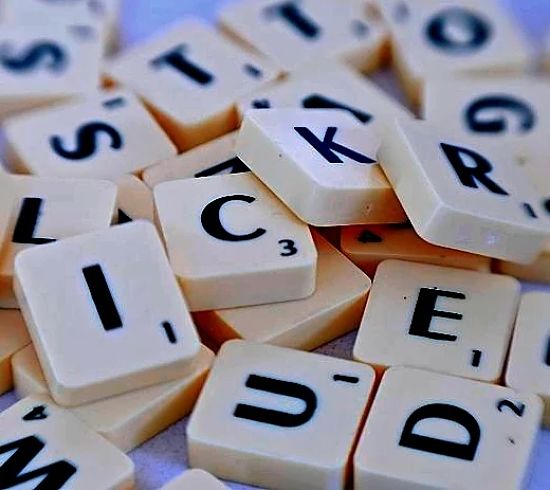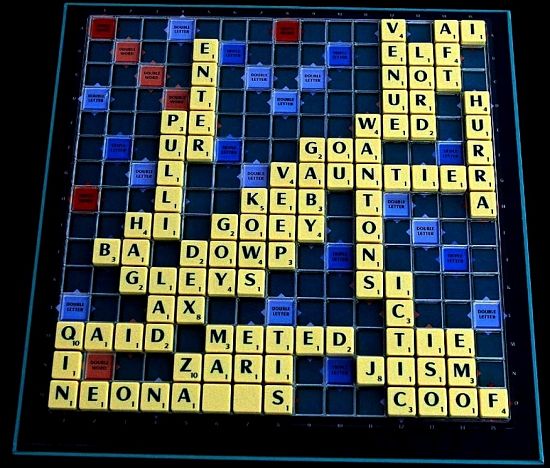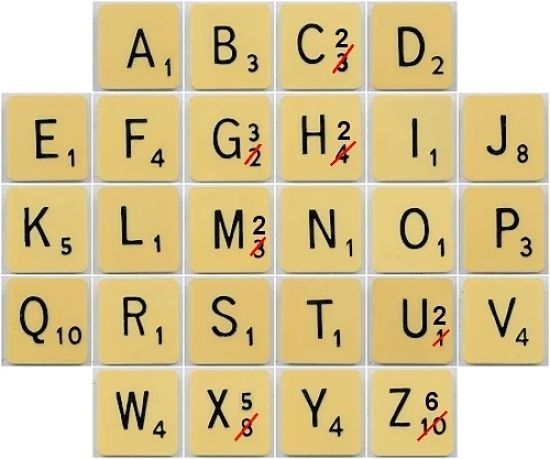Scrabble Letter Values Need to be Updated - Pros and Cons
There have been many calls to change the letter values for the popular game of Scrabble. Originally, Alfred Butts, who invented the game in 1938, assigned the values to each letter based on the frequency of occurrence of each letter on the front page of the New York Times.
Since then a lot has changed, including the frequency of letters on newspaper pages.
The Scrabble dictionary of legal words has changed considerably to allow a lot short words containing Q, Z and X.
Therefore, while Z and Q have been assigned the largest letter value of 10 in Scrabble, they are now relatively easier to play.
Similarly X has been assigned a value of 8, when a value of 5 would now seem more appropriate.
Better research on letter frequency for all the words in the Oxford Dictionary has also highlighted some apparent errors in the letter values originally assigned for letter C, G and H.
There are many differences of opinion about whether the letter values should be changed to make the game "fairer", or that the vales should remain unchanged because the concept of fairness is irrelevant and any changes would cause a catastrophic reaction from people who love the game.
This article examines the justification for the changes in letter values and highlights those letters that have 'unfair values'.



Scrabble Letter Scores and Frequency of Occurrence
The image above highlights some of the proposed changes.
How well does the original frequency of occurrence devised from the front page of the New York Times in the 1930s, compare with modern data and modern usage. In the table below three sets of data have been complied from various sources on frequency of occurrence.
- Data used for devising 'Morse Code'. Samuel Morse, the inventor of the code, needed information on letter frequency so he could assign the simplest codes to the most commonly used letters. So he counted the number or time each letter occurred in sets of printers' type.
- Modern Frequency of occurrence data for thousands of publications
- Frequency of letters in words listed in Oxford Dictionary
- Proportional use of letters for words in The Oxford Dictionary relative to Q set at a value of '1'
The second table below summarizes the differences by showing a listing of the letters ranked by frequency of occurrence.
The tables show that the original ranking was very good. The major discrepancies have been highlighted. They are:
- The letter H has a lower ranking for occurrence and perhaps should have a letter score of 3 rather than 4. The frequency of occurrence for H is more similar to M, P and D.
- The letter C has a lower ranking for occurrence and perhaps should have a letter score of 1 rather than 3.
- The letter G has a higher ranking for occurrence and could have a letter score of 3 or 4 rather than 2.
A full list of changes suggested by researchers in this area are:
- Z: 6 (changed from 10)
- X: 5 (changed from 8)
- U: 2 (changed from 1)
- M: 2 (changed from 3)
- K: 4 (changed from 5)
- H: 2 (changed from 4)
- F: 3 (changed from 4)
- Y: 3 (changed from 4)
- V: 5 (changed from 4)
- P: 2 (changed from 3)
- L: 2 (changed from 1)
- J: 6 (changed from 8)
- G: 3 (changed from 2)
- C: 2 (changed from 3)
The reasons for the other changes are:
- Z really only deserves six points because it is more frequently used now, especially in short words allowed in the Scrabble Dictionary of words. Z is much easier to use than Q, and so it should have a lower value.
- X (worth eight points now) is only worth 5 points
- M (worth three points now) is only worth 2 points
There are many other things that change the ability to use particular letters such as:
- The frequency with which letters occur at the start and end of words
- The frequency of occurrence in words of different length
- Associations between various letters such a Q and U, etc.
Arguments For The Changes
The letter values should truly reflect the real difficulty is using the letter in words. If there are errors this means that people who pick up the tiles with the wrong values are placed at a disadvantage.
Arguments against making the changes
- It is a game of luck and changing the tile values wouldn't achieve anything
- Any tile values changes would resisted by the makers of the game and would cause a huge outcry amongst the millions of players, especially if two versions were developed, with revised letter values for tournaments.
- Seasoned Scrabble players are already aware of the differences between the value on the tile and the real value when played in a game. They already take this into consideration, and some people refer to it as "equity value". Blank tiles and S tiles have values that far exceed their face value and can earn a player bonus points. These equity values are already built into the way that people play the game
- Scrabble is not a game where 'fairness' is not really the issue, and changing the tile values wouldn't really achieve anything. What tiles you get depends on luck, and the skills in the game depend on making best use of the tiles you have in front of you.
Letter Ranking for Scrabble Compared with Frequency of Occurrence in Publications and Words
|
Letter values
|
Scrabble Letter Rank
|
Letter General Frequency of Occurrence Rank
|
Letter Frequency of Occurrence for Words in the Oxford Dictionary
|
||
|---|---|---|---|---|---|
|
10
|
Q
|
Q
|
Q
|
||
|
10
|
Z
|
Z
|
J
|
||
|
8
|
J
|
X
|
Z
|
||
|
8
|
X
|
J
|
X
|
||
|
5
|
K
|
K
|
K
|
||
|
4
|
xxx
|
H
|
V
|
V
|
|
|
4
|
W
|
B
|
W
|
||
|
4
|
V
|
P
|
Y
|
||
|
4
|
F
|
G
|
F
|
ttt
|
|
|
4
|
Y
|
F
|
B
|
||
|
3
|
B
|
Y
|
G
|
||
|
3
|
###
|
C
|
W
|
H
|
xxx
|
|
3
|
M
|
M
|
M
|
||
|
3
|
P
|
C
|
P
|
||
|
2
|
D
|
D
|
D
|
||
|
2
|
ttt
|
G
|
U
|
U
|
|
|
1
|
U
|
L
|
C
|
###
|
|
|
1
|
L
|
R
|
L
|
||
|
1
|
T
|
H
|
S
|
||
|
1
|
S
|
S
|
N
|
||
|
1
|
N
|
I
|
T
|
||
|
1
|
O
|
N
|
O
|
||
|
1
|
I
|
O
|
I
|
||
|
1
|
R
|
A
|
R
|
||
|
1
|
A
|
T
|
A
|
||
|
1
|
E
|
E
|
E
|
Letters Ranked by Value
|
Letter
|
Scrabble Letter Values
|
Morse Frequency
|
Modern Frequency
|
Frequency of letters in words listed in Oxford Dictionary
|
Proportional use relative to Q set at value of '1'
|
|---|---|---|---|---|---|
|
Q
|
10
|
0.5%
|
0.1%
|
0.2%
|
1.0
|
|
Z
|
10
|
0.2%
|
0.1%
|
0.3%
|
1.4
|
|
J
|
8
|
0.4%
|
0.2%
|
0.2%
|
1.0
|
|
X
|
8
|
0.4%
|
0.2%
|
0.3%
|
1.5
|
|
K
|
5
|
0.8%
|
0.9%
|
1.1%
|
5.6
|
|
F
|
4
|
2.4%
|
2.0%
|
1.8%
|
9.2
|
|
H
|
4
|
6.0%
|
6.1%
|
3.0%
|
15.3
|
|
V
|
4
|
1.1%
|
1.1%
|
1.0%
|
5.1
|
|
W
|
4
|
1.9%
|
2.3%
|
1.3%
|
6.6
|
|
Y
|
4
|
1.9%
|
2.0%
|
1.8%
|
9.1
|
|
B
|
3
|
1.5%
|
1.5%
|
2.1%
|
10.6
|
|
C
|
3
|
2.8%
|
2.7%
|
4.5%
|
23.1
|
|
M
|
3
|
2.8%
|
2.5%
|
3.0%
|
15.4
|
|
P
|
3
|
1.6%
|
1.7%
|
3.2%
|
16.1
|
|
D
|
2
|
4.2%
|
4.1%
|
3.4%
|
17.3
|
|
G
|
2
|
1.6%
|
1.9%
|
2.5%
|
12.6
|
|
A
|
1
|
7.5%
|
8.3%
|
8.5%
|
43.3
|
|
E
|
1
|
11.3%
|
12.6%
|
11.2%
|
56.9
|
|
I
|
1
|
7.5%
|
6.7%
|
7.5%
|
38.5
|
|
L
|
1
|
3.8%
|
4.2%
|
5.5%
|
28.0
|
|
N
|
1
|
7.5%
|
6.8%
|
6.7%
|
33.9
|
|
O
|
1
|
7.5%
|
7.7%
|
7.2%
|
36.5
|
|
R
|
1
|
5.8%
|
5.7%
|
7.6%
|
38.6
|
|
S
|
1
|
7.5%
|
6.1%
|
5.7%
|
29.2
|
|
T
|
1
|
8.5%
|
9.4%
|
7.0%
|
35.4
|
|
U
|
1
|
3.2%
|
2.9%
|
3.6%
|
18.5
|